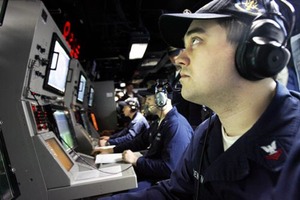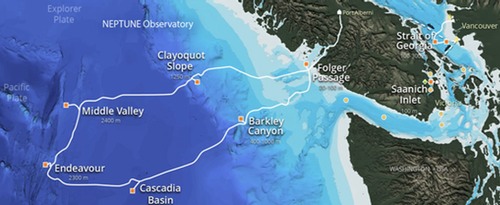Ocean observatory audio streams: navies nix bits of data that scientists savor
Bioacoustics, News, Ocean, Science, Shipping, Sonar Add commentsFor several years, AEI has been excited about the ever-expanding networks of ocean observatories coming online around the world. A recent article on LiveScience detailed some of the benefits of the arrays of research stations deployed offshore by Ocean Network Canada, which collect all manner of data: physical, chemical, biological, geological, and acoustic. Their two networks, the offshore NEPTUNE (left below) and the near-shore VENUS (right below), consist of permanent installations on the floor (“nodes,” shown as orange squares below) as well as mobile moored sensors that may take measurements higher in the water column (yellow dots). A similar US network, dubbed Regional Scale Nodes, is being planned off the coast of Washington and Oregon.
While the observatories are enabling in-depth study of complex process in ways not previously possible (click that link for a glimpse of the amazing topics being explored…yes, do it!), the audio feeds coming from some of the nodes hold special excitement for many researchers. “If you want to study what’s going on in the ocean, the best tool by far is sound,” said Tom Dakin, an acoustic specialist at ONC’s sensors technology development office.”There are all kinds of sounds being made in the ocean, and they all have a telltale signature. . . . If you start putting in a bunch of external man-made noise, [whales] are going to have a hard time communicating,” Dakin said. It’s like trying to have a conversation with somebody at a rock concert — you have to shout, you can’t hold a conversation for very long and you wouldn’t be able to detect different inflections that you would normally be able to hear. He has been diving when a big ship has gone by, and “it feels like somebody’s whacking you in the chest with a two-by-four,” he said.
 But while scientists are keen to hear what the new undersea recordings have to tell us, the US and Canadian Navies are far less enthusiastic. They’re concerned that the audio feeds, which are freely available to scientists and the public as downloads and via live online feeds, will reveal sensitive information about submarine and ship movements, navy training activities, and even the sound signatures of individual vessels. The two navies have arranged with researchers to have an audio bypass switch that allows them to divert the audio streams into a secured military computer—sitting in a locked cage at the research facility where the data comes ashore—at times when their ships are nearby (and also at some random other times, so that their diversions don’t give away any secrets on their own!). This article from The Atlantic dug into the way this system works, along with a quick look at naval concerns about sound from as far back as 1918. The data diversions from Ocean Networks Canada’s system (often triggered by the US Navy) occur several times a month and last from hours to days. As noted by The Atlantic:
But while scientists are keen to hear what the new undersea recordings have to tell us, the US and Canadian Navies are far less enthusiastic. They’re concerned that the audio feeds, which are freely available to scientists and the public as downloads and via live online feeds, will reveal sensitive information about submarine and ship movements, navy training activities, and even the sound signatures of individual vessels. The two navies have arranged with researchers to have an audio bypass switch that allows them to divert the audio streams into a secured military computer—sitting in a locked cage at the research facility where the data comes ashore—at times when their ships are nearby (and also at some random other times, so that their diversions don’t give away any secrets on their own!). This article from The Atlantic dug into the way this system works, along with a quick look at naval concerns about sound from as far back as 1918. The data diversions from Ocean Networks Canada’s system (often triggered by the US Navy) occur several times a month and last from hours to days. As noted by The Atlantic:
While the Canadian military has yet to return a request for comment, the U.S. Navy reminds me that naval ship movements are classified information, and the fact that those movements might potentially be broadcast on the internet is obviously of concern. “The value of having a cabled system is that it releases data live to the internet,” says U.S. Navy oceanographer Wayne Estabrooks. “But there are some times where we want to protect information, so we have to do diversions.”
…
“There’s a long tradition of the ocean being the exclusive domain of the militaries and the fishing community, and we’re more or less interlopers in this world,” says [Kim] Juniper, the microbiologist who showed me the photo of the computer in the cage. “The world is changing. . . It’s going to come to a point in the future where this is no longer going to be feasible for the navies to put resources into sorting all this data,” he later says. The hydrophones alone generate 200 gigabytes of raw data each day, and there are other, similar networks of Internet-connected sensors that already exist, or are soon to come online.
Dakin notes, though, that only 4% of the data is lost, and is returned to the science pipeline, often immediately and nearly always within a week. The military filters out their ship noise, but leaves the rest of the data intact (at least, whatever data is not also in the frequency range of the navy ships or other sensitive sonic activities). “At end of the day, we hardly miss any data at all,” he says. You can listen to live streams of ONC acoustic data here, and, since that’s rarely very exciting, to a collection of highlights of images and sounds here.

